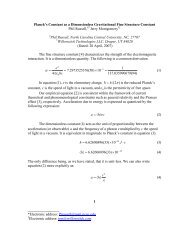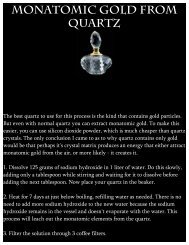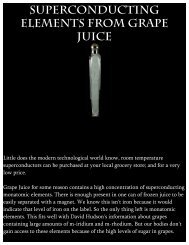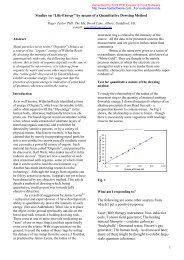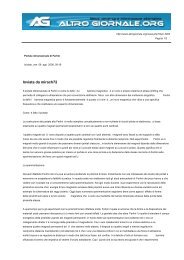Viktor Schauberger
Viktor Schauberger
Viktor Schauberger
Create successful ePaper yourself
Turn your PDF publications into a flip-book with our unique Google optimized e-Paper software.
kept out of the entire SS disc development programs for security reasons and the fact that the SS was a<br />
state-within-a-state with its own production facilities, war material, scientists and technicians, slave<br />
workforce, and the knowledge of secret Third Reich military bases outside Germany where these discs<br />
were both tested and stored.<br />
Among those held, <strong>Viktor</strong> <strong>Schauberger</strong> became the leader of most interest due to his highly<br />
unconventional use of liquid vortex technology which was perfected while he was in custody at<br />
Mauthausen. Originally designed for an odd bio-submarine, the strange Repulsin discoid motors<br />
were to be adapted to aircraft. Heinkel was the first to receive the results of these early discoid tests but<br />
refused to act on it. A year after the Repulsin Model A motor was being studied one of Heinkel‟s own<br />
engineers named Rudolf Schriever proposed his own "Flugkreisel" (Flying Gyro) that utilized<br />
conventional jet engines instead of the Repulsin discoid motor. His design was taken from him and<br />
handed over to a team of scientists for further study and the construction of a large flying prototype. The<br />
team consisted of Dr. Richard Miethe, Klaus Habermohl, and an Italian- Dr. Guiseppe Belluzzo, who<br />
had come up with his own design for a jet powered round flying bomb- the Turboproietti.<br />
Meanwhile, BMW started work on a design very similar to Schriever’s Flugkreisel but utilizing the<br />
company‟s own BMW 003 jet engines. These machines, called „Flugelrads" (Winged Wheels) were not<br />
really true disc aircraft but jet autogyros that used a standard BMW 003 with a Strahlrohr (Jet pipe)<br />
deflector to power a multi-blade disc rotor. These craft were built on a much smaller scale than<br />
Schriever‟s Flugkreisel so work proceeded from 1941-45 with construction of prototypes beginning in<br />
1943. Instability, however, was never really solved in the earlier designs. One disc, however, a BMW<br />
Fluglerad II V-2 possibly achieved flight in April 1945.<br />
Schriever‟s own disc began to take shape in 1943 as well and flew under jet power provided by three<br />
attached special kerosene-burning jet engines driving the disc rotor as well as two kerosene jets on the<br />
body for forward thrust and horizontal stability.<br />
Flight characteristics were good but then the SS decided to abruptly drop Schriever‟s jet-fan design in<br />
favor of Miethe‟s version that eliminated the large disc rotor blades driven by jet engines for<br />
<strong>Schauberger</strong>‟s liquid vortex engine, but on a larger scale. With <strong>Schauberger</strong> released back to Austria<br />
in 1944 by the SS, the Miethe disc took to the air that same year over the Baltic.<br />
At the same time a private venture with official backing from Air Ministry General Udet was taking shape<br />
in Leipzig. Arthur Sack who caught the attention of Udet way back in 1939 with his A.S.1 circular wing<br />
flying aero model was given permission and some funding to build a manned large-scale version of his<br />
model. Sack took up the challenge and built 4 more models of increasing size. When the A.S.5<br />
demonstrated that the basic concept was sound construction began on the manned version in early<br />
1944- the A.S.6. Within a month the strange largely wooden aircraft utilizing salvaged parts from a ME<br />
BF 108 was taxiing and making attempts to fly. But this project was doomed from the start with an<br />
underpowered engine and plagued by structural problems which meant the aircraft could hop- but never<br />
fly.



